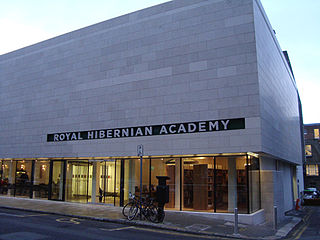Related Research Articles
Anne Madden is an English-born painter, who is well known in both Ireland and France where she has divided her time since her marriage to Louis le Brocquy in 1958.

Daniel Maclise was an Irish history painter, literary and portrait painter, and illustrator, who worked for most of his life in London, England.

The Royal Hibernian Academy (RHA) is an artist-based and artist-oriented institution in Ireland, founded in Dublin in 1823. Like many other Irish institutions, such as the RIA, the academy retained the word "Royal" after most of Ireland became independent as the Irish Free State in December 1922.
Edward John Carlos Plunkett, 20th Baron of Dunsany, with Irish, Brazilian and UK citizenship, was the grandson of the author Lord Dunsany, and a modern artist and landowner. Lord Dunsany succeeded to the title in 1999 on the death of his father, Lt-Col Randal Arthur Henry Plunkett, 19th Baron of Dunsany.

Major Sir William Newenham Montague Orpen, was an Irish artist who worked mainly in London. Orpen was a fine draughtsman and a popular, commercially successful painter of portraits for the well-to-do in Edwardian society, though many of his most striking paintings are self-portraits.
Basil Joseph BlackshawHRUA, HRHA was a Northern Irish artist specialising in animal paintings, portraits and landscapes and an Academician of the Royal Ulster Academy.

Colin Middleton was a Northern Irish landscape artist, figure painter, and surrealist. Middleton's prolific output in an eclectic variety of modernist styles is characterised by an intense inner vision, augmented by his lifelong interest in documenting the lives of ordinary people. He has been described as ‘Ireland's greatest surrealist.’

John Henry Foley, often referred to as J. H. Foley, was an Irish sculptor, working in London. he is best known for his statues of Daniel O'Connell in Dublin, and of Prince Albert for the Albert Memorial in London.

George Barret Sr. was an Irish landscape artist best known for his oil paintings, but also sometimes produced watercolours. He left Ireland in 1762 to move to London where he soon gained recognition as a leading artist of the period. He exhibited at the Society of Artists of Great Britain and was able to gain patronage from many leading art collectors. Barrett with other leading members left the Society in 1768 to found the Royal Academy, where he continued to exhibit until 1782.

Thomas Malton, was an English painter of topographical and architectural views, and an engraver. J. M. W. Turner and Thomas Girtin were amongst his pupils. He is designated "the younger" to differentiate him from his father Thomas Malton, the Elder.

Dublin Opinion was an Irish satirical magazine, published monthly from 1922 to 1968. It was founded by cartoonists Arthur Booth and Charles E. Kelly and writer Thomas J. Collins. Booth was its first editor, and drew the covers of the early issues. The first issue was launched on 1 March 1922, and its entire print run of 3,000 sold out. The next issue sold poorly, but from the third issue the magazine was distributed by Eason & Son and sales improved, rising to 40,000 per issue within four years, and 60,000 at its peak.
William St. John Glenn (1904–1974) was an Irish-British illustrator, painter and comics artist.
Flora Mitchell was an American-born Irish artist, remembered in particular for her mid-20th-century paintings of old Dublin architecture that has since disappeared.
Mary Swanzy HRHA was an Irish landscape and genre artist. Noted for her eclectic style, she painted in many styles including cubism, futurism, fauvism, and orphism, she was one of Ireland's first abstract painters.
Terence Philip FlanaganPPRUA HRUA RHAMBE was a landscape painter and teacher from Northern Ireland.

Alfred Ernest Egerton Cooper, RBA, ARCA, was a British painter of portraits, landscapes and other figurative work. In the era of Modernism, he continued to work in traditional style from his studio in Chelsea, London.
William Crawford MitchellARCA, ARUA was an Ulster artist who specialized in lino-cuts and wood engraving.
Paul Yates is a British poet, painter and film-maker, born in Belfast, who initially came to prominence in Northern Ireland when his poems were chosen for broadcast on BBC Radio Ulster in 1970. Two years later, the Tom Caldwell Gallery in Belfast hosted his first solo exhibition.
References
- ↑ Theo Snoddy, "Dictionary of 20th Century Irish Artists".
- ↑ The Irish Times, Monday Dec 24th 1990, illustrated article by Kathy Sheridan.
- ↑ The Evening press, Friday 23rd Sept 1970. "Ballyscunnion, The village That's All In The Mind."
- ↑ The Chelsea News March 20th 1970. Photo of the Opening of the Ballyscunnion Exhibition.
- ↑ The Irish Times March 17, 1970. "Ballyscunnion in London", article within "An Irishman's Diary".
- ↑ The Irish Times June 12th 1974 "William John Glenn RUA" an article by Rowel Friers. See also Chelsea News June 14, 1974, "William St. John Glenn, An Appreciation."